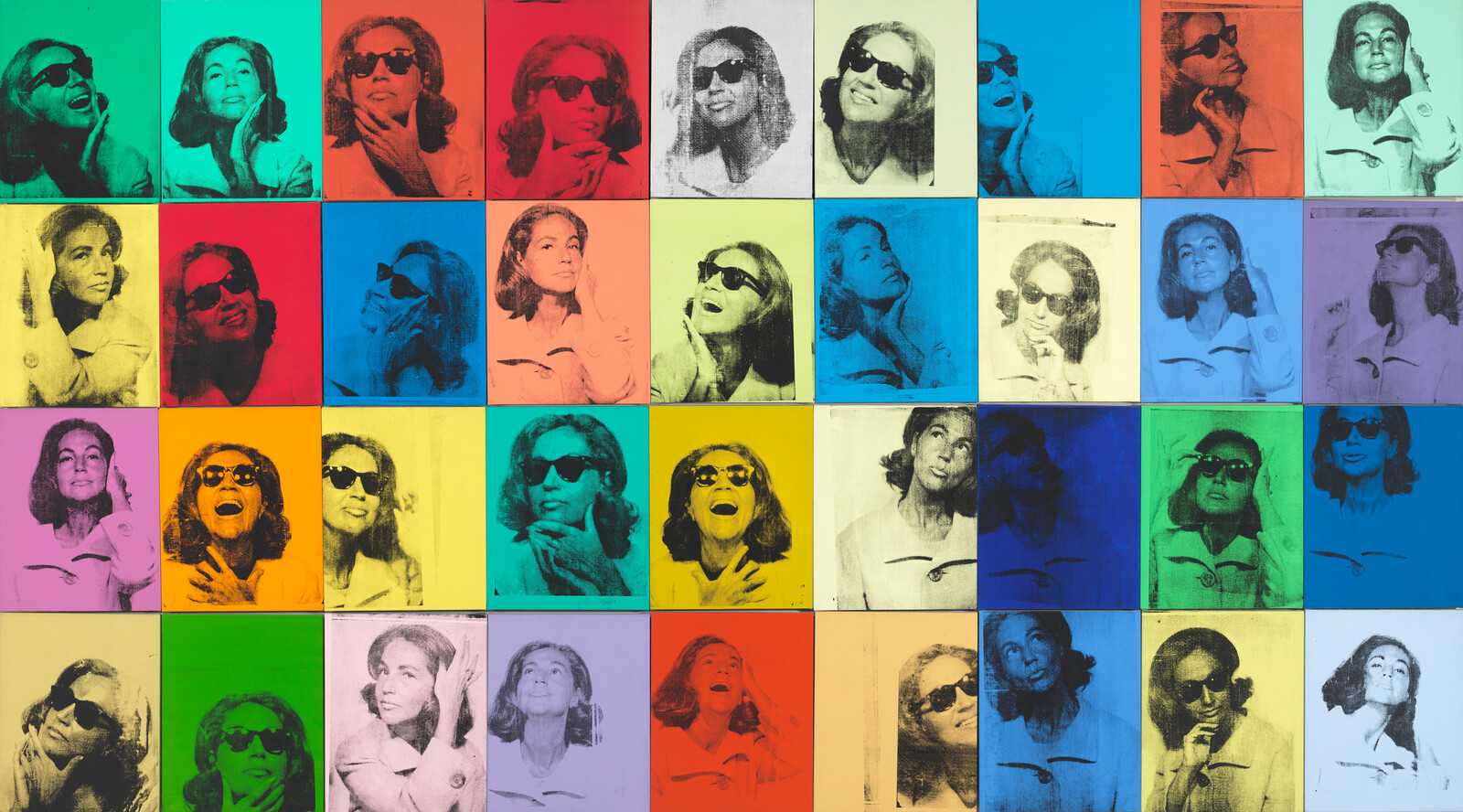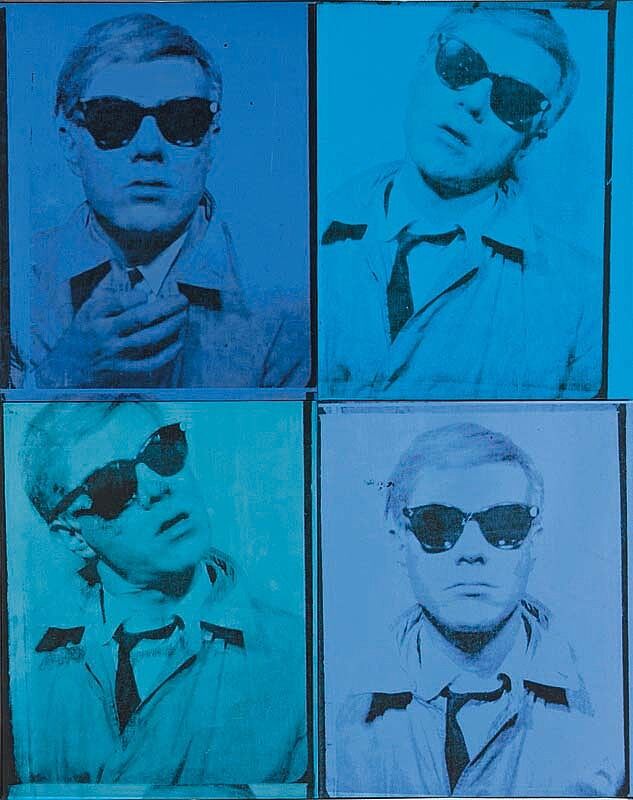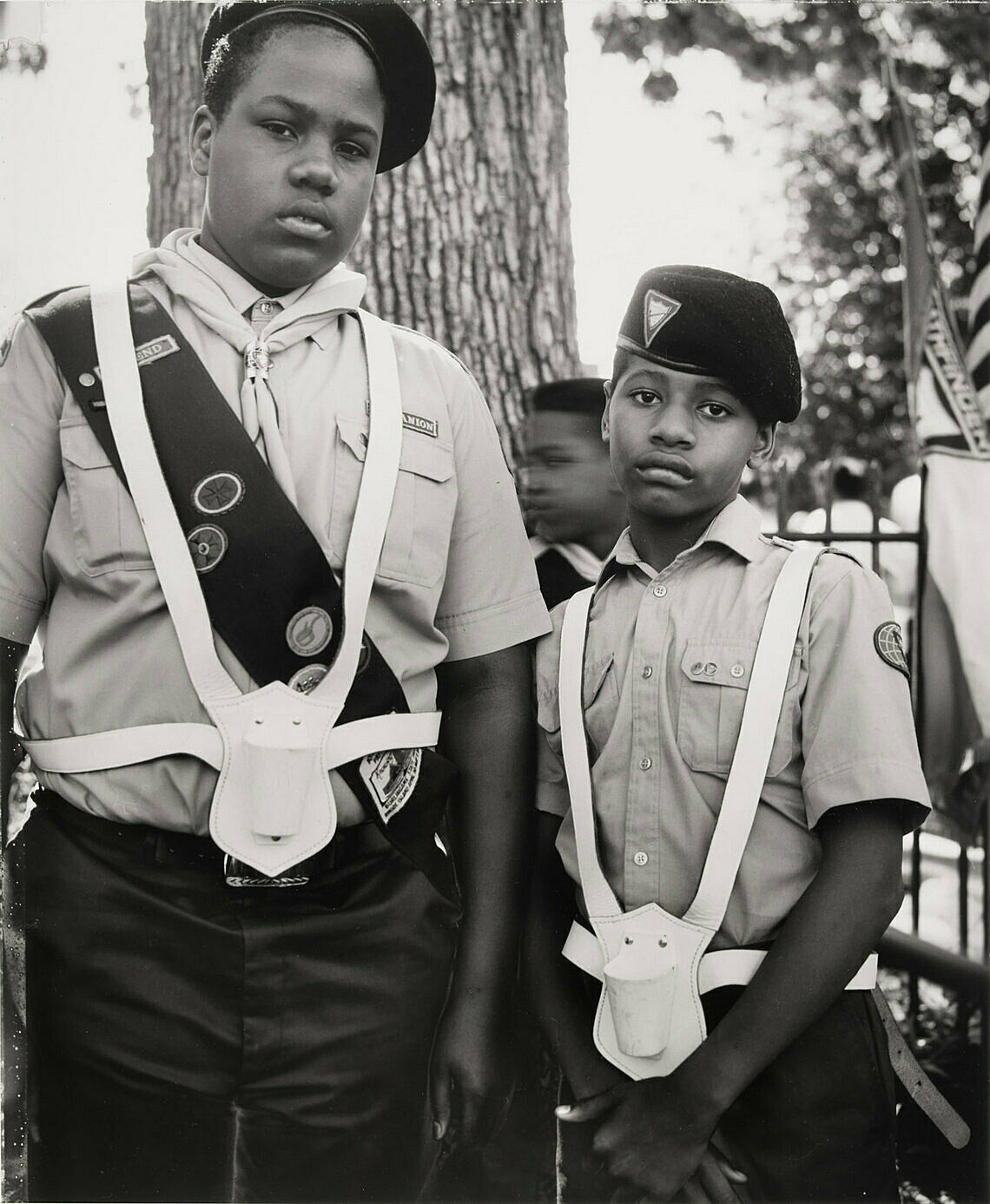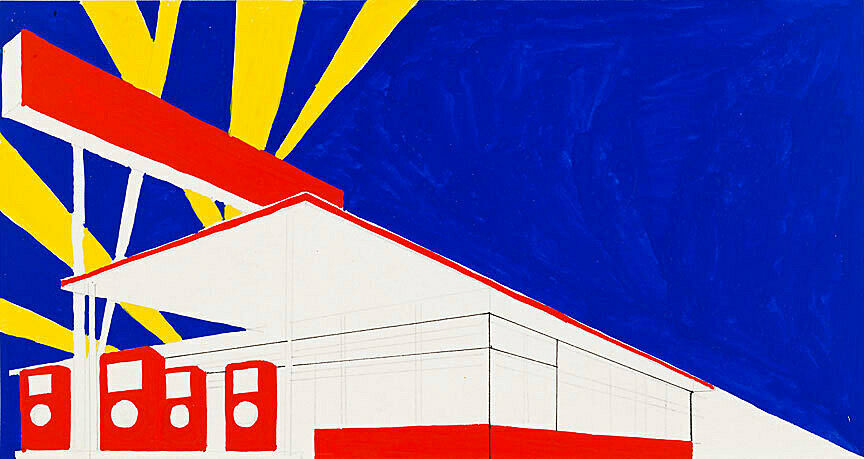Visual description
Ethel Scull 36 Times was made in 1963, and was Warhol’s first commissioned portrait painting. This painting measures twelve feet wide by six and a half feet tall. It is composed of thirty-six individual screenprints, each one on a separate canvas that is twenty inches tall by sixteen inches wide. All of them are hung vertically, in four rows of nine screenprints each.
The subject of the piece, Ethel Scull, was a wealthy art collector, who eventually accumulated one of the largest collections of Pop art in the world. Each canvas is based a photograph of her, all in the same format and from the same distance. In fact, Warhol used a Times Square photobooth to shoot all of the pictures in rapid succession. Scull is glamorously styled, with soft, wavy hair, a large collar on her coat, and dark sunglasses. She poses in ways reminiscent of celebrity photo shoots—her head resting on the palm of her hand, one hand running through her hair, or her gazing out into the distance. In most of the photos, Ethel Scull is smiling or laughing; in others, she seems pensive and thoughtful; in still others, she is jokingly pouting or coyly looking into the camera. Because the photos are so clearly from the same photoshoot, it becomes obvious that all of these emotions were put on for the benefit of the artist. Rather than capturing a true moment, Warhol here is highlighting the artifice that goes into some photography, especially photography of celebrities.
Warhol painted each canvas a solid color before printing the images on it. All thirty-six canvases have their own unique color background, though some belong in the same color family. About a third of the canvases are painted in bright, deep reds, oranges, and yellows, colors one might experience in autumn leaves or ripe apples. Another third are painted with rich blues, greens, teals, and purples, colors reminiscent of ocean life. The final third are more muted, pale, and pastel versions of all the other colors, as might be used to paint Easter eggs. There is no discernible order to how Warhol placed these colors within his grid of canvases. They are all jumbled together, with warm colors next to cool or bright next to muted. Placed in this scattered way, they create a spectacular display of color.
On view
Floor 7
Date
1963
Classification
Paintings
Medium
Acrylic and screenprint on canvas, thirty-six parts
Dimensions
Overall: 80 × 144 in. (203.2 × 365.8 cm)
Overall (each): 20 × 15 7/8 in. (50.8 × 40.3 cm)
Accession number
86.61a-jj
Credit line
Jointly owned by the Whitney Museum of American Art and The Metropolitan Museum of Art; Gift of Ethel Redner Scull
Rights and reproductions
© The Andy Warhol Foundation for the Visual Arts, Inc. / Licensed by Artists Rights Society (ARS), New York
Videos
Audio
-
0:00
Descripción verbal: Andy Warhol, Ethel Scull 36 veces, 1963
0:00
Narrador: Ethel Scull 36 veces fue pintado en 1963 y fue el primer retrato por comisión de Warhol. Esta pintura mide 3.6 metros de ancho por 2 metros de alto. Está compuesta por 36 serigrafías individuales, cada una en un lienzo separado que mide 50 centímetros de alto por 40 centímetros de ancho. Todas ellas están colgadas verticalmente, en cuatro filas de nueve serigrafías cada una.
La protagonista de la obra, Ethel Scull, era una adinerada coleccionista de arte que acabó acumulando una de las mayores colecciones de arte pop del mundo. Cada lienzo se basa en una fotografía de ella, todas con el mismo formato y tomadas desde la misma distancia. De hecho, Warhol utilizó un fotomatón de Times Square para tomar todas las fotos en rápida sucesión. Scull aparece con un estilo glamoroso, con el pelo suave y ondulado, un gran cuello en su abrigo y gafas de sol oscuras. Posa de manera similar a sesiones fotográficas de celebridades, con la cabeza apoyada en la palma de la mano, una mano pasando por su pelo o mirando a lo lejos. En la mayoría de las fotos, Ethel Scull sonríe o se ríe; en otras, parece pensativa y reflexiva; en otras, hace un puchero en broma o mira tímidamente a la cámara. Como las fotos son claramente de la misma sesión, resulta obvio que todas estas emociones fueron fingidas para el artista. En lugar de capturar un momento real, Warhol destaca aquí el artificio involucrado en algunas fotografías, especialmente en las de las celebridades.
Warhol pintó cada lienzo de un color sólido antes de imprimir las imágenes sobre él. Los treinta y seis lienzos tienen su propio fondo de color único, aunque algunos pertenecen a la misma familia de colores. Aproximadamente un tercio de los lienzos están pintados en rojos, naranjas y amarillos brillantes e intensos, colores que se pueden ver en las hojas otoñales o en las manzanas maduras. Otro tercio está pintado con azules, verdes, turquesas y morados intensos, colores que recuerdan a la vida marina. El último tercio son versiones más apagadas, pálidas y pastel de todos los demás colores, como los que se podrían utilizar para pintar huevos de Pascua. No hay un orden discernible en la forma en que Warhol colocó estos colores dentro de su cuadrícula de lienzos. Están todos mezclados, con colores cálidos junto a fríos o brillantes junto a apagados. Colocados de esta manera dispersa, crean un espectacular despliegue de color.
-
0:00
Verbal Description: Andy Warhol, Ethel Scull 36 Times, 1963
0:00
Narrator: Ethel Scull 36 Times was made in 1963, and was Warhol’s first commissioned portrait painting. This painting measures 12 feet wide by 6.5 feet tall. It is composed of thirty-six individual screenprints, each one on a separate canvas that is twenty inches tall by sixteen inches wide. All of them are hung vertically, in four rows of nine screenprints each.
The subject of the piece, Ethel Scull, was a wealthy art collector, who eventually accumulated one of the largest collections of Pop art in the world. Each canvas is based on a photograph of her, all in the same format and from the same distance. In fact, Warhol used a Times Square photobooth to shoot all of the pictures in rapid succession. Scull is glamorously styled, with soft, wavy hair, a large collar on her coat, and dark sunglasses. She poses in ways reminiscent of celebrity photo shoots—her head resting on the palm of her hand, one hand running through her hair, or her gazing out into the distance. In most of the photos, Ethel Scull is smiling or laughing; in others, she seems pensive and thoughtful; in still others, she is jokingly pouting or coyly looking into the camera. Because the photos are so clearly from the same photoshoot, it becomes obvious that all of these emotions were put on for the benefit of the artist. Rather than capturing a true moment, Warhol here is highlighting the artifice that goes into some photography, especially photography of celebrities.
Warhol painted each canvas a solid color before printing the images on it. All thirty-six canvases have their own unique color background, though some belong in the same color family. About a third of the canvases are painted in bright, deep reds, oranges, and yellows, colors one might experience in autumn leaves or ripe apples. Another third are painted with rich blues, greens, teals, and purples, colors reminiscent of ocean life. The final third are more muted, pale, and pastel versions of all the other colors, as might be used to paint Easter eggs. There is no discernible order to how Warhol placed these colors within his grid of canvases. They are all jumbled together, with warm colors next to cool or bright next to muted. Placed in this scattered way, they create a spectacular display of color.
-
0:00
Andy Warhol, Ethel Scull 36 Times, 1963
0:00
Narrator: Ethel Scull was Warhol’s first portrait commission. She had expected that he would make a painting of her in his studio. But when he picked her up from her Fifth Avenue apartment, that’s not how things went.
Richard Meyer: He puts her in the taxi cab, they go down to Times Square, he took her into an arcade, and he put her in a photo booth machine where you put—at that point it was four for a quarter.
Narrator: Professor Richard Meyer.
Richard Meyer: So he started feeding quarters into the machine and saying to Ethel Scull, "Don't just sit there! Do something, take your sunglasses off, put your fingers through your hair, smile" and he just started basically directing her.
He kept feeding quarters into it until they had over a hundred different images.
You get the sense that Ethel Scull, in this photo booth machine, becomes an actress, and the character she's embodying is a version—or maybe multiple versions—of herself. And yes, it is herself as a celebrity. And that's, I think, what all those people who commissioned portraits of Warhol in the seventies who weren't famous wanted. They wanted the Warhol brand. It wasn't yet a brand here. Yet, this is what helped it become a brand, but they wanted to look famous through Warhol's style of painting them.
-
Ethel Scull 36 Times, 1963
In “Untitled” (America) and Andy Warhol—From A to B and Back Again (Spanish)
0:00
Ethel Scull 36 Times, 1963
0:00
Narrator: Ethel Scull fue el primer retrato por encargo de Warhol. Ella esperaba que el artista realizara la pintura en su estudio. Pero cuando él pasó a recogerla por su departamento en la Quinta Avenida, los hechos siguieron otro camino.
Richard Meyer: La sube a un taxi y juntos van a Times Square; la lleva a un centro de juegos y la hace entrar a una cabina fotográfica donde se coloca una moneda de 25 centavos, eso costaba entonces, para sacar cuatro fotografías.
Narrator: Profesor Richard Meyer
Richard Meyer: Y él comienza a depositar monedas en la máquina, mientras le dice a Ethel Scull, "Ok, ya sabes, no te quedes ahí sentada, ¡posa! Haz algo, quítate las gafas de sol, desliza los dedos entre el cabello, sonríe", y comienza a dirigirla.
Continuó depositando monedas hasta obtener más de cien imágenes diferentes.
Uno siente que Ethel Scull se convierte en actriz dentro de la cabina fotográfica y que el personaje que encarna es una versión, o quizá múltiples versiones, de ella misma. Y, sí, es ella que aparece como una celebridad. Creo que eso era lo que querían todas las personas que no eran famosas y que le comisionaron retratos a Warhol en los años setenta. Querían la marca Warhol, aunque todavía no era una marca establecida. Sin embargo, eso es lo que ayudó a que se convirtiera en una marca, el deseo de esas personas de parecer famosas a través del estilo que Warhol usaba para pintarlas.
-
0:00
Verbal Description: Ethel Scull 36 Times, 1963
0:00
Narrator: Ethel Scull 36 Times was made in 1963, and was Warhol’s first commissioned portrait painting. This painting measures twelve feet wide by six and a half feet tall. It is composed of thirty-six individual screenprints, each one on a separate canvas that is twenty inches tall by sixteen inches wide. All of them are hung vertically, in four rows of nine screenprints each.
The subject of the piece, Ethel Scull, was a wealthy art collector, who eventually accumulated one of the largest collections of Pop art in the world. Each canvas is based a photograph of her, all in the same format and from the same distance. In fact, Warhol used a Times Square photobooth to shoot all of the pictures in rapid succession. Scull is glamorously styled, with soft, wavy hair, a large collar on her coat, and dark sunglasses. She poses in ways reminiscent of celebrity photo shoots—her head resting on the palm of her hand, one hand running through her hair, or her gazing out into the distance. In most of the photos, Ethel Scull is smiling or laughing; in others, she seems pensive and thoughtful; in still others, she is jokingly pouting or coyly looking into the camera. Because the photos are so clearly from the same photoshoot, it becomes obvious that all of these emotions were put on for the benefit of the artist. Rather than capturing a true moment, Warhol here is highlighting the artifice that goes into some photography, especially photography of celebrities.
Warhol painted each canvas a solid color before printing the images on it. All thirty-six canvases have their own unique color background, though some belong in the same color family. About a third of the canvases are painted in bright, deep reds, oranges, and yellows, colors one might experience in autumn leaves or ripe apples. Another third are painted with rich blues, greens, teals, and purples, colors reminiscent of ocean life. The final third are more muted, pale, and pastel versions of all the other colors, as might be used to paint Easter eggs. There is no discernible order to how Warhol placed these colors within his grid of canvases. They are all jumbled together, with warm colors next to cool or bright next to muted. Placed in this scattered way, they create a spectacular display of color.
-
0:00
Ethel Scull 36 Times, 1963
0:00
Narrator: Ethel Scull was Warhol’s first portrait commission. She had expected that he would make a painting of her in his studio. But when he picked her up from her Fifth Avenue apartment, that’s not how things went.
Richard Meyer: He puts her in the taxi cab, they go down to Times Square, he took her into an arcade, and he put her in a photo booth machine where you put—at that point it was four for a quarter.
Narrator: Professor Richard Meyer.
Richard Meyer: So he started feeding quarters into the machine and saying to Ethel Scull, "Don't just sit there! Do something, take your sunglasses off, put your fingers through your hair, smile" and he just started basically directing her.
He kept feeding quarters into it until they had over 100 different images.
You get the sense that Ethel Scull, in this photo booth machine, becomes an actress, and the character she's embodying is a version—or maybe multiple versions—of herself. And yes, it is herself as a celebrity. And that's, I think, what all those people who commissioned portraits of Warhol in the seventies who weren't famous wanted. They wanted the Warhol brand. It wasn't yet a brand here. Yet, this is what helped it become a brand, but they wanted to look famous through Warhol's style of painting them.
Exhibitions
Installation photography
-
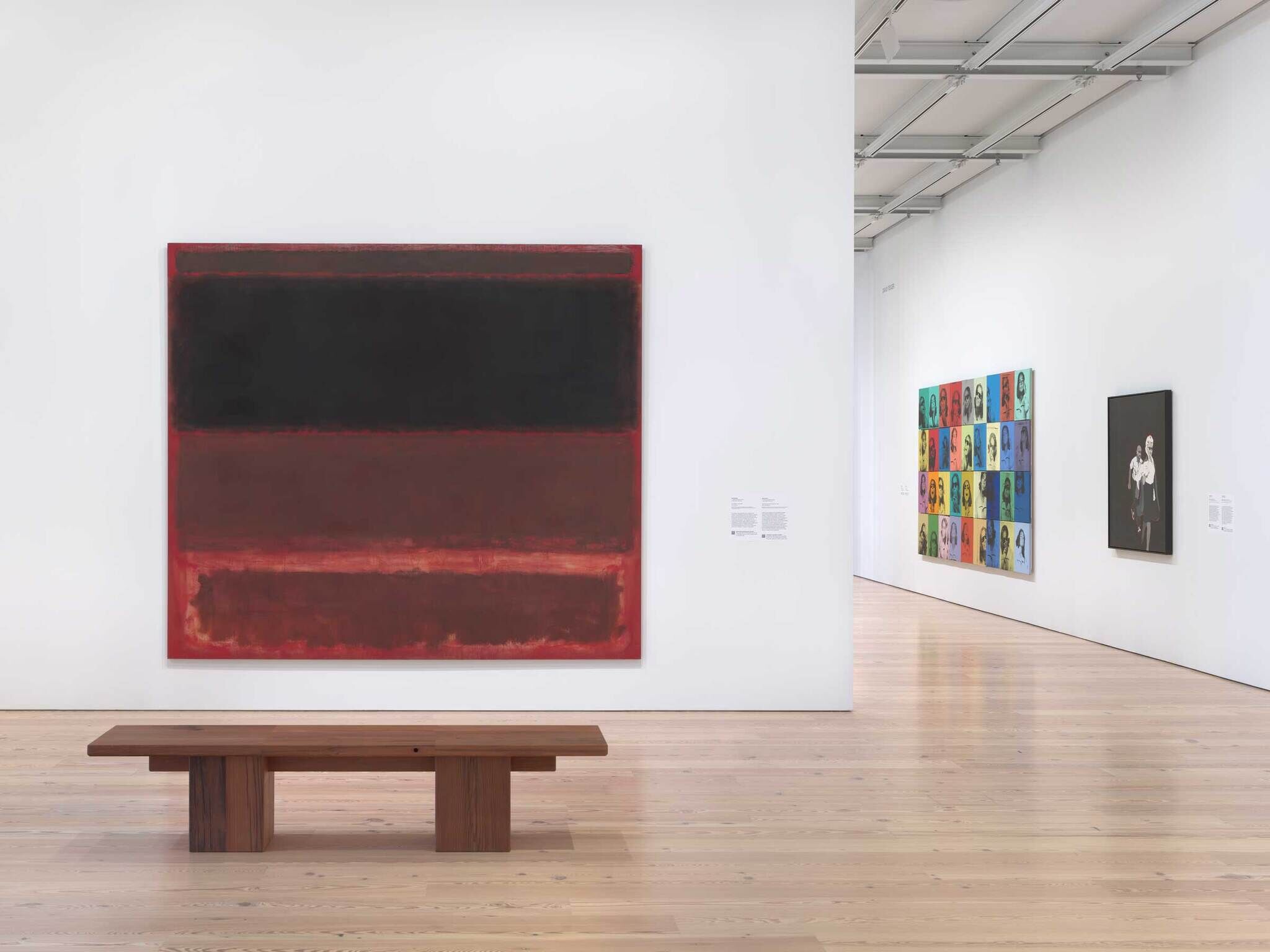

Installation view of “Untitled” (America) (Whitney Museum of American Art, New York, July 5, 2025-). From left to right: Mark Rothko, Four Darks in Red, 1958; Andy Warhol, Ethel Scull 36 Times, 1963; Rosalyn Drexler, Marilyn Pursued by Death, 1963. Photograph by Ron Amstutz
From the exhibition “Untitled” (America)
-
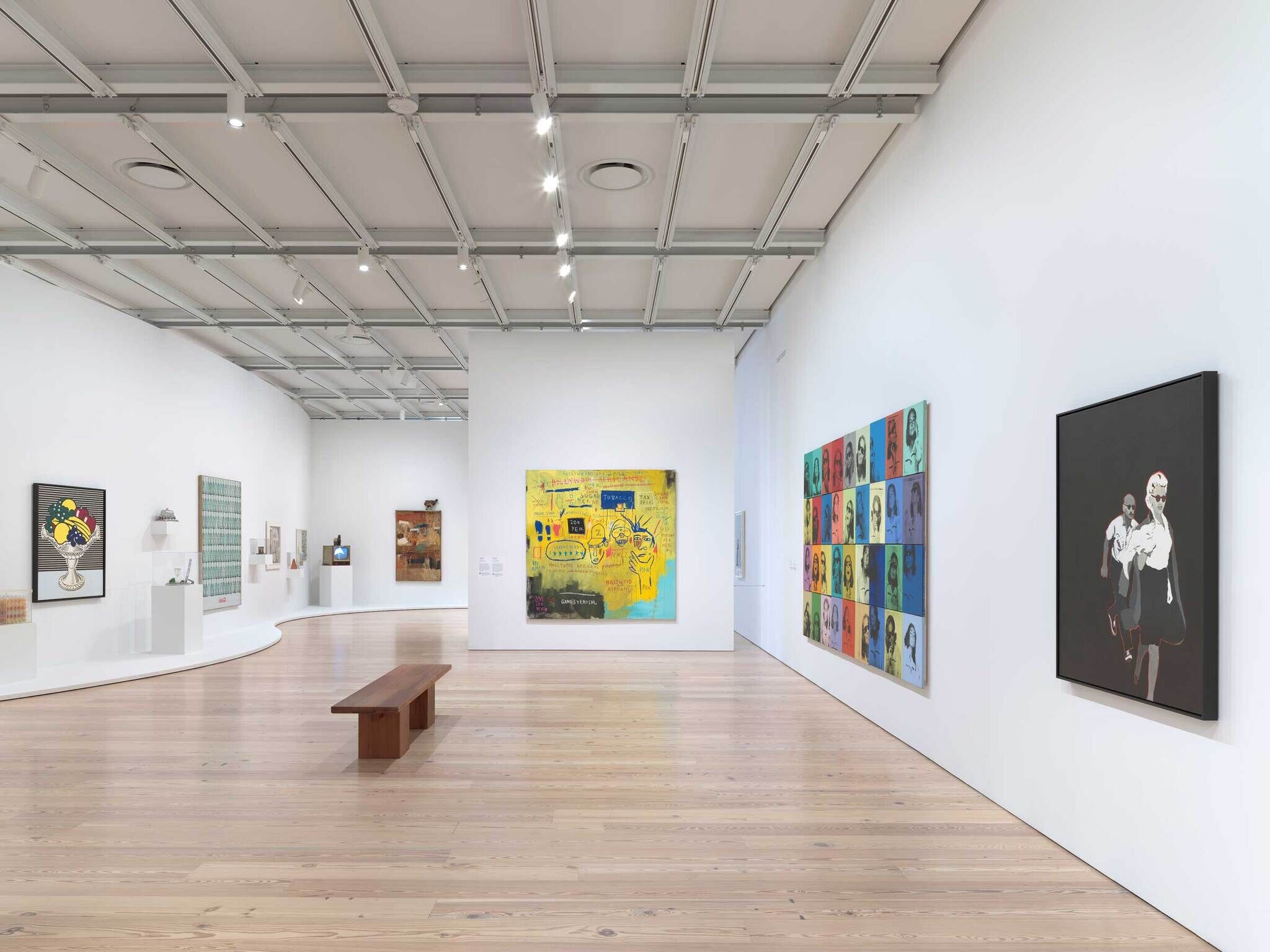

Installation view of “Untitled” (America) (Whitney Museum of American Art, New York, July 5, 2025-). From left to right: Robert Watts, Case of Eggs (with Rainbow Wax Eggs), 1964; Roy Lichtenstein, Still Life with Crystal Bowl, 1972; Jeff Koons, Jim Beam - Passenger Car, 1986; Lucas Samaras, Dinner #15, 1965; Man Ray, New York, 1917/1966; Andy Warhol, Green Coca-Cola Bottles, 1962; Jasper Johns, Painted Bronze, 1960 (cast and painted 1964); Gerald Murphy, Cocktail, 1927; Betye Saar, I’ve Got Rhythm, 1972; Mary Bauermeister, Homage to Marbert Du Breer, 1964; Nam Jun Paik, Magnet TV, 1965; Robert Rauschenberg, Satellite, 1955; Jean-Michel Basquiat, Hollywood Africans, 1983; Andy Warhol, Ethel Scull 36 Times, 1963; Rosalyn Drexler, Marilyn Pursued by Death, 1963. Photograph by Ron Amstutz
From the exhibition “Untitled” (America)
-
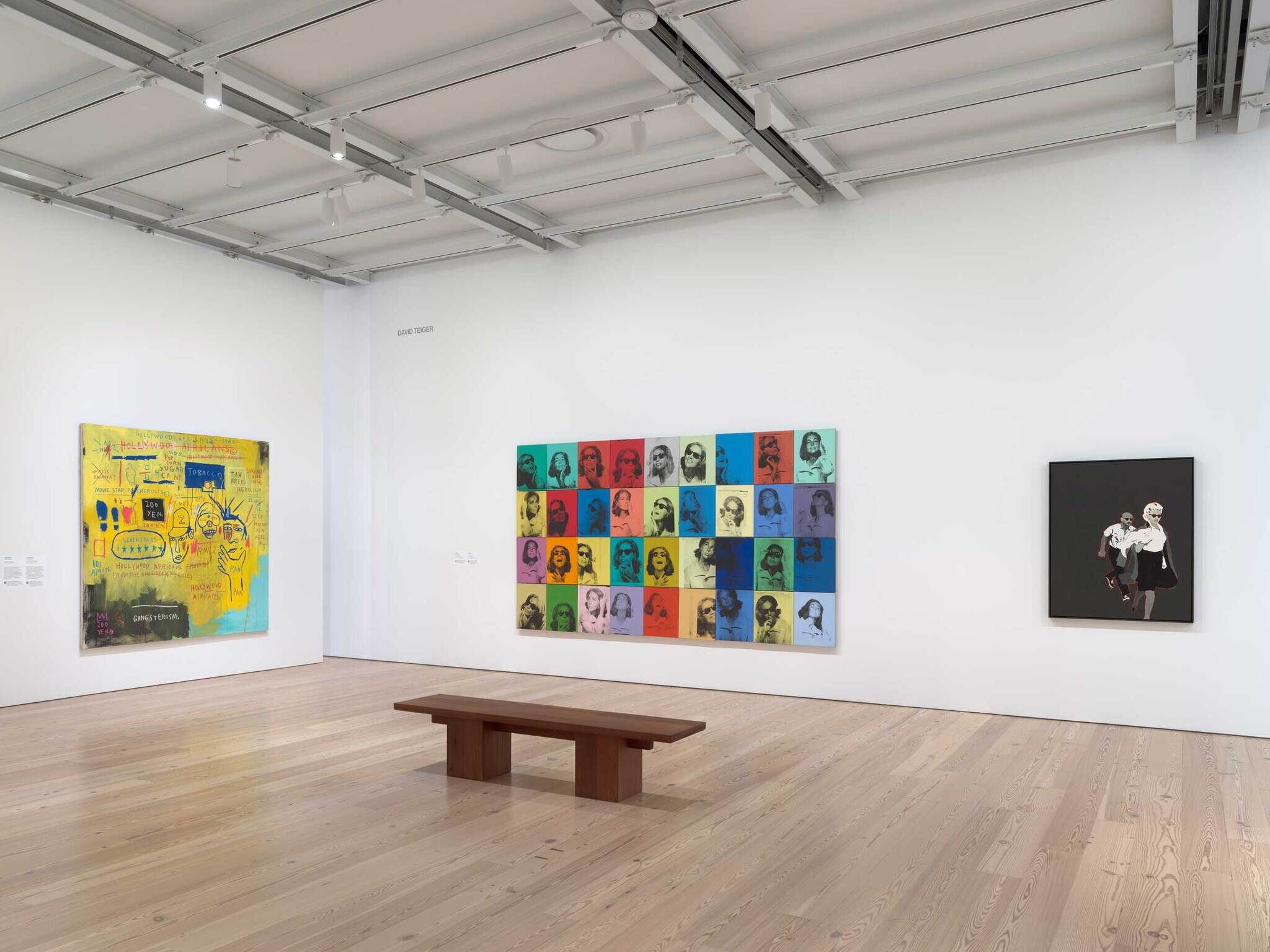

Installation view of “Untitled” (America) (Whitney Museum of American Art, New York, July 5, 2025-). From left to right: Jean-Michel Basquiat, Hollywood Africans, 1983; Andy Warhol, Ethel Scull 36 Times, 1963; Rosalyn Drexler, Marilyn Pursued by Death, 1963. Photograph by Ron Amstutz
From the exhibition “Untitled” (America)
-
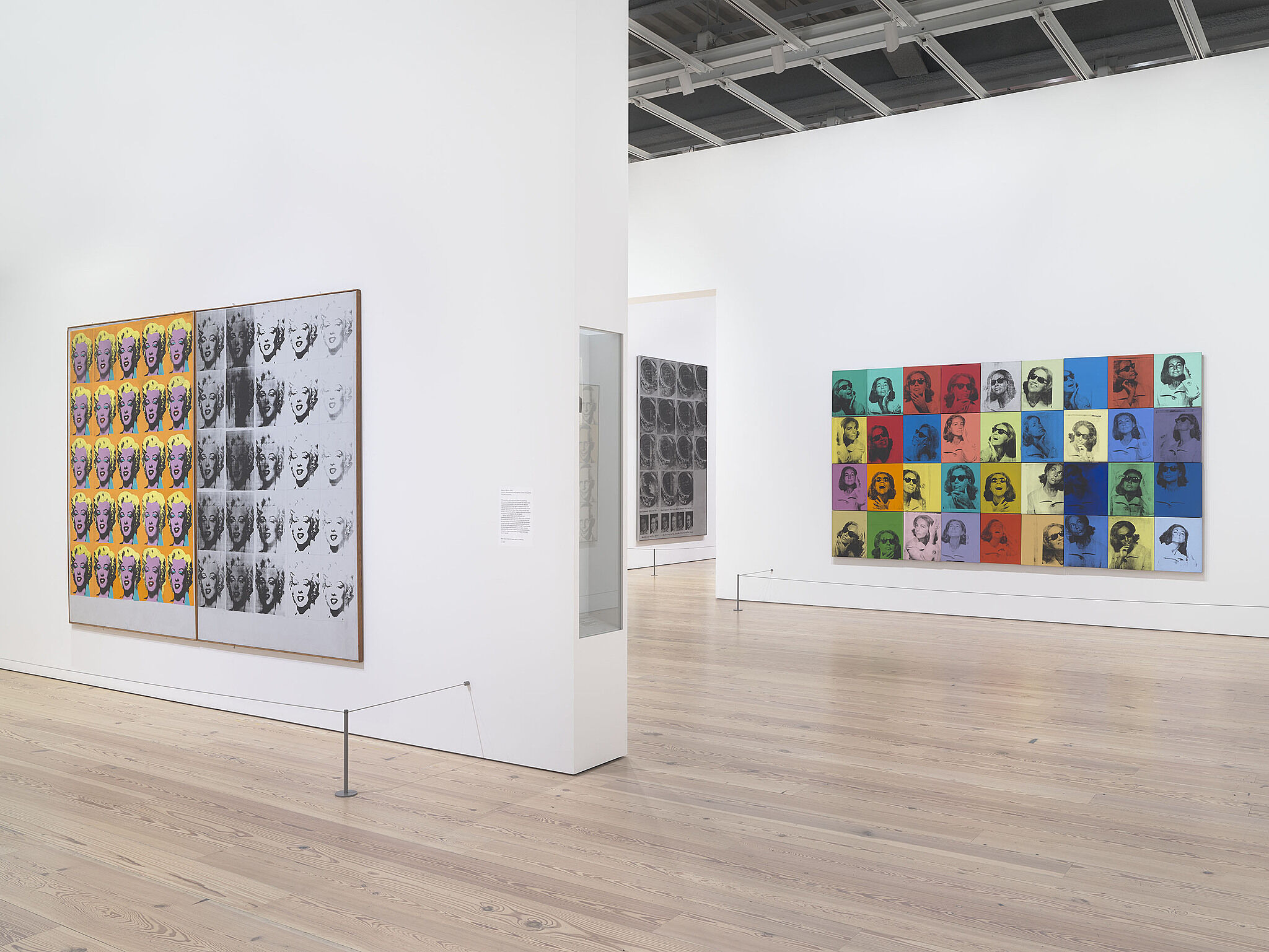

Installation view of Andy Warhol – From A to B and Back Again (Whitney Museum of American Art, New York, November 12, 2018–March 31, 2019). From left to right: Marilyn Diptych, 1962; Tunafish Disaster, 1963; Ethel Scull 36 Times, 1963. Photograph by Ron Amstutz. © 2018 The Andy Warhol Foundation for the Visual Arts, Inc. / Licensed by Artists Rights Society (ARS), New York
From the exhibition Andy Warhol—<br>From A to B and <br>Back Again

